What are hidden signs in a Word. How to remove unprintable characters in a Word
As you probably know, in text documents, in addition to visible signs (punctuation marks, etc.), there are also invisible, or rather, non-printable. These include spaces, tabs, spacing, page breaks, and section breaks. They are in the document, but they are not visually indicated in any way, however, if necessary, they can always be viewed.
Note:The mode of displaying non-printable characters in MS Word allows not only to simply see them, but also, if necessary, recognize and remove unnecessary indents in the document, for example, double spaces or tabs instead of spaces. Also, in this mode, you can distinguish between a regular space and a long, short, quadruple or continuous space.
Although Word's nonprintable character display mode is very useful in many cases, it can be a serious problem for some users. So, many of them, having enabled this mode by mistake or unknowingly, cannot figure out how to disable it on their own. It is about how to remove unprintable characters in the Word we will explain below.
Note: As the name implies, non-printable characters are not printed, they are simply displayed in a text document if this view mode is activated.
If in your word document the mode of displaying non-printable characters is on, it will look something like this:
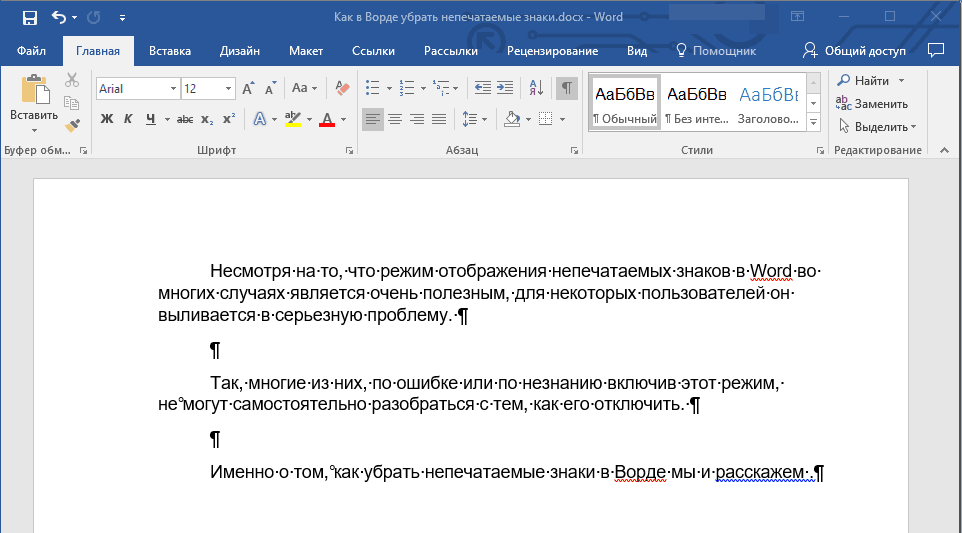
At the end of each line there is a character “¶” , it also appears on blank lines if there are any in the document. You can find the button with this symbol on the control panel in the tab "The main" in Group "Paragraph"... It will be active, that is, pressed - this means that the mode of displaying non-printable characters is on. Therefore, to disable it, you just need to press the same button again.
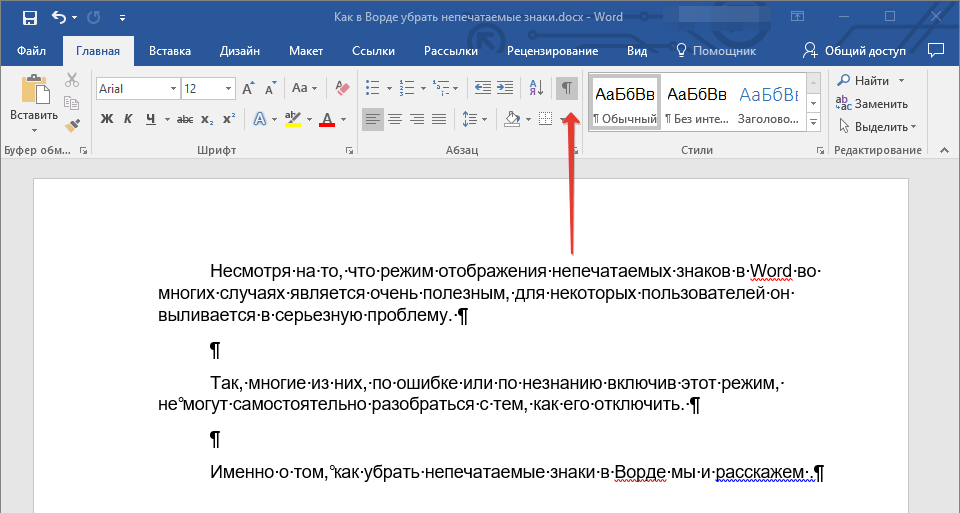
Note:In versions of Word earlier than 2012, the group "Paragraph", and with it the button for enabling the mode of displaying non-printable characters, are located in the tab "Page layout" (2007 and up) or "Format"(2003).

However, in some cases, the problem is not easily solved, especially Microsoft Office for Mac users complain. By the way, users who jumped from old version product to a new one, too, can not always find this button. In this case, it is better to use a key combination to turn off the mode of displaying non-printable characters.
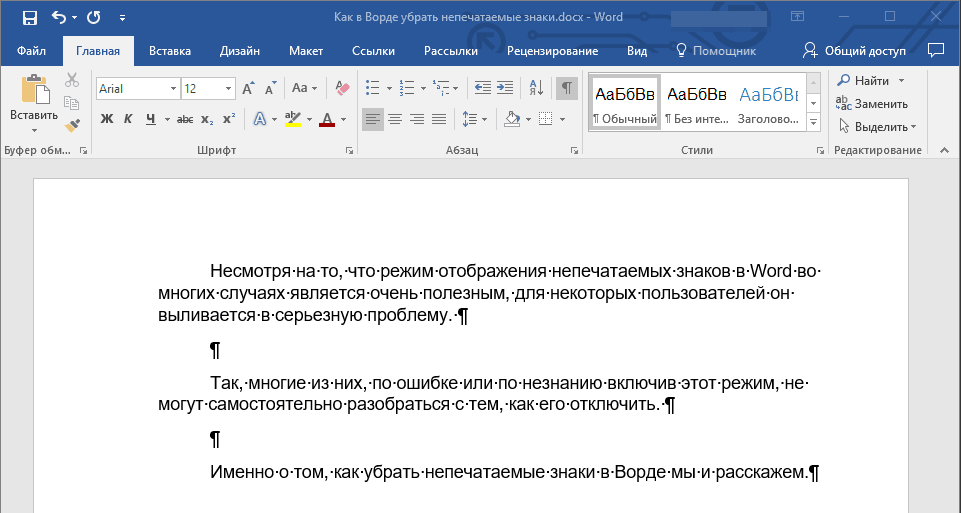
Just click "CTRL + SHIFT + 8".
Non-printable character display will be disabled.

If this did not help you, it means that in the settings of the Word, it is necessary to display non-printable characters along with all other formatting characters. To disable their display, follow these steps:
1. Open the menu "File" and select item "Options".
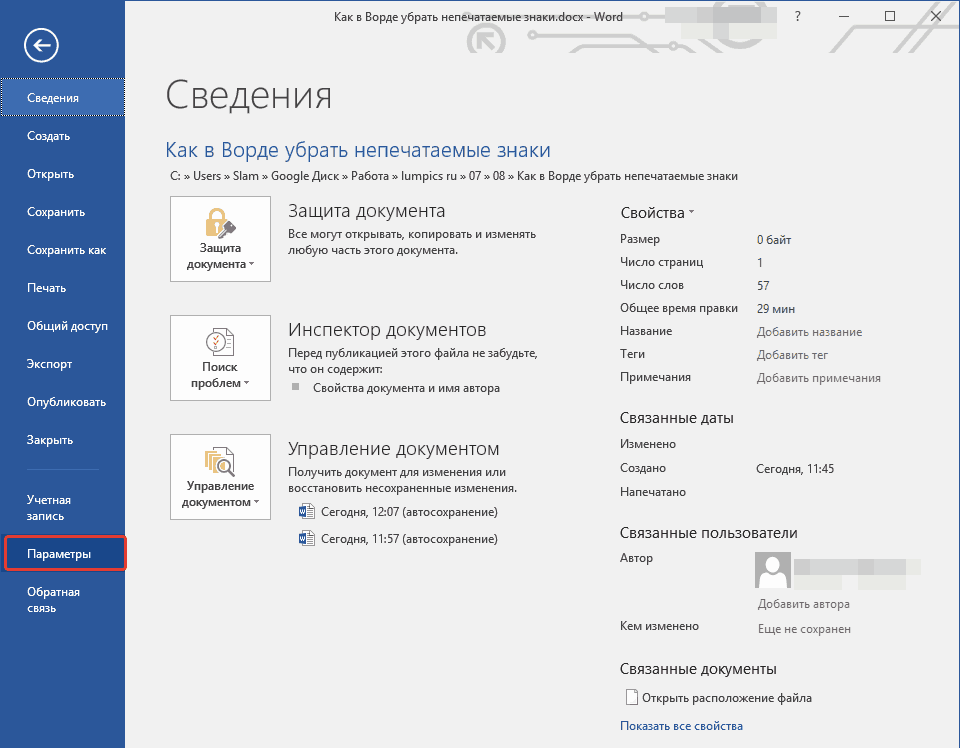
Note: Previously in MS Word instead of a button "File" there was a button "MS Office"and section "Options" was called "Word Options".
2. Go to the section "Screen" and find the item there "Always show these formatting characters on screen".
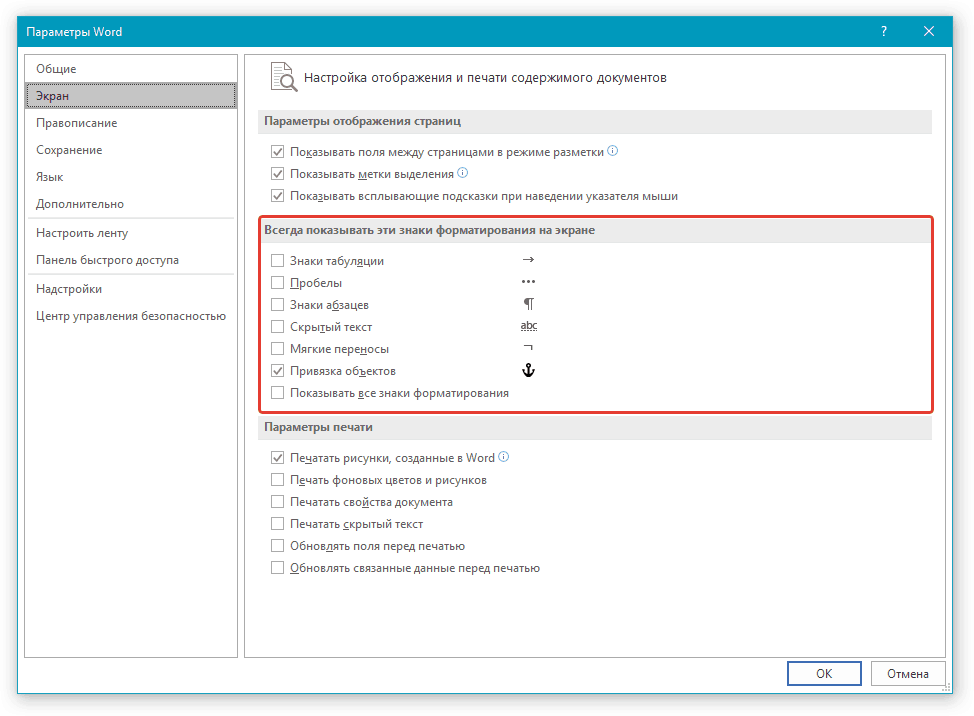
3. Uncheck all boxes except "Snapping objects".
4. Now non-printable characters will definitely not appear in the document, at least until you enable this mode yourself by pressing the button on the control panel or using key combinations.
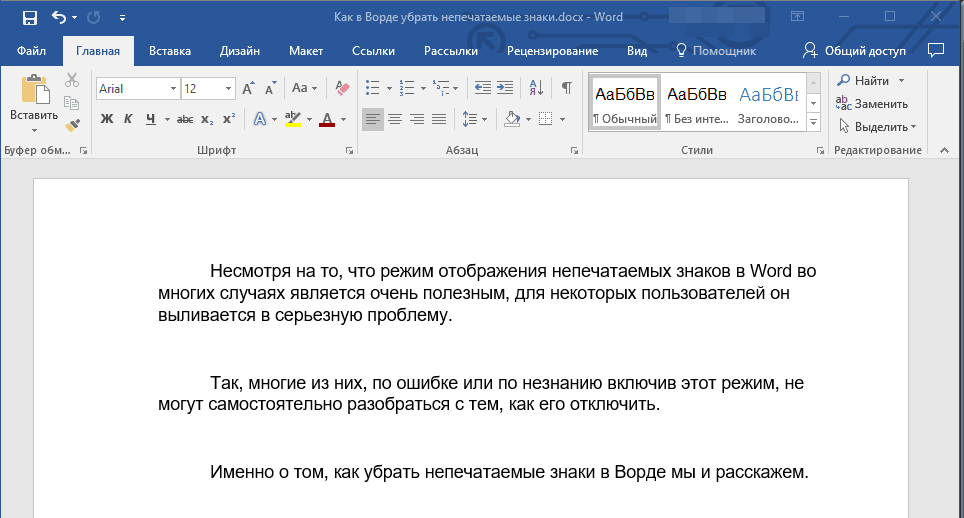
That's all, from this short article you learned how to disable the display of non-printable characters in a Word text document. I wish you success in further mastering the functionality of this office program.
Do you think this is what is called "obscene language"? Nothing like this. These are characters that simply cannot be typed in the Find box of the Find and Replace dialog box, and their correct name is non-printable. Try typing here, for example, a tab character: press the key
To search for special hidden characters, in the dialog box Find and replace click on the button More, then on the button Special (fig. 5.3). You will see a list different charactersthat Word can find, but which, as you can see, are damn hard to type (Figure 5.4).
Select any special character from this list, and its special, sometimes funny, designation will appear in the Find field (for example, At- for tabs). Click on the button Find Next, and Word starts searching for that character.
- Any character, Any digit, Any letter - can represent various information. These symbols are used as stencils of symbols in which you substitute the search terms you need.
- Cap Mark - Finds the caret character (l), which is a special character feature. If you just enter this character (L), Word will take it as a signal that a special character will be entered next.
- The paragraph mark (¶) is the same as the Enter character; you enter it at the end of each paragraph by pressing the key
- Tab character - Moves the cursor to the next tab stop.
- White space symbol - means any white space (space, tab, etc.).
Figure: 5.4. This list can be used to search for special characters
By the way, you can use special characters and normal text at the same time, i.e. if you need to find a word Numberpreceded by a tab character, enter a tab character (on the screen it will look like ^ t) using a list Specialand the word Number dial manually. It looks something like this:
^ tQuantity
You don't have to use the Special list if you can remember the list of service symbols. I refer to it all the time because I know that the ^ p keyboard shortcut replaces the key
- Paragraph mark ^ p
- Tab character ^ t
- Any ^ sign?
- Any digit ^ #
- Any letter ^ $
- Cover sign ^^
- Line break ^ I
- Page break ^ m
- Empty space ^ w
In addition to the basic content, there are characters in a Word document that normally don't appear on the screen. Some special word symbols uses for its own purposes. For example, characters that signal the end of a line or paragraph.
Word treats them as non-printable characters. Why display them in a document? Because when these symbols are visible, it is easier to understand the spacing and layout of the document.
For example, you can easily determine where you put two spaces between words or made an extra end of a paragraph. But to see the document as it will be printed, you need to hide these characters. We will teach you how to easily hide and display non-printable characters.
Note: The illustrations for this article are from Word 2013.
To display special non-printable characters, click the tab File (File).

In the menu on the left, click on Options (Options).

On the left side of the dialog box Word options (Word Options) click Screen (Display).

In the parameter group Always show these formatting marks on screen (Always show these formatting marks on the screen) check the boxes for the non-printable characters that you want to always display in your document. The (Show all formatting marks) parameter enables the display of all non-printable characters in the document at once, regardless of the above items.


You can also turn on the display of non-printable characters by clicking on the button that looks like an uppercase Latin letter P (only mirrored). This symbol is Paragraph mark... The button is in the section Paragraph (Paragraph) tab the main (Home).
Note: Reverse letter-like button P, performs the same task as the parameter Show all formatting marks (Show all formatting marks), which we looked at just above. Turning one on or off directly affects the state of the other.
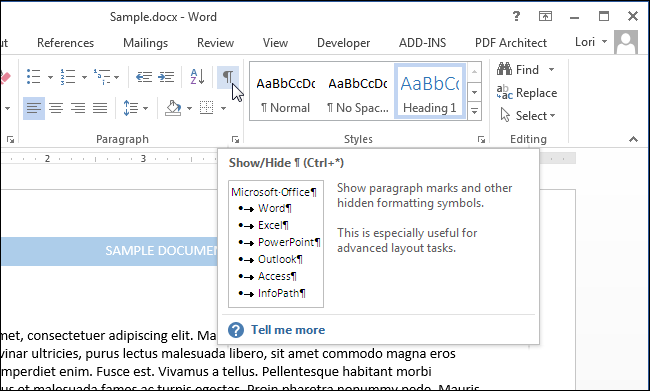
Please note that the formatting characters you choose on the tab Screen (Display) dialog box Word options (Word Options) will be shown in any case, even if you choose to hide non-printable characters by clicking on the paragraph mark button.
When working with text document in word program 2007 there is a setting for displaying non-printable characters. What non-printable characters and what are they for? For beginners, non-printable characters are more frightening (as well as display) than a desire to work with incomprehensible characters on the page. After all, non-printable characters are, at first glance, obscure icons, dots and arrows, and this, as it seems to them, only makes it difficult to work with text. However, for professionals, each non-printable character is a hint and help, which in the document was edited by mistake. Therefore, for correct and professional editing of documents, train yourself to work immediately with non-printable characters in Word. Non-printing service characters - paragraphs, tabs, spaces, tables, figures, etc. - help to correctly navigate the document, to see typing and formatting mistakes: extra spaces, tabs, paragraphs, etc.
Important to know: non-printable characters displayed only on the monitor screen and not printed, and regardless of whether they are viewed or not.They are deleted, like all other characters, numbers and letters - with the Delete and Backspace keys.
How do I customize the display of non-printable characters in a text box? How do I enable non-printable characters?
To display non-printable characters in Word 2007, follow these steps:1.In open document go to the "Home" tab.
2. In the "Paragraph" group, click on the "Show all characters" button (see Fig. 1)
Figure: 1. Command "Show all characters" (non-printable characters)
Note... If the button is activated, the characters are displayed, if not, the characters are not visible.
Hotkeys to enable and disable non-printable characters
Ctrl + * - keyboard shortcut in Word 2007 to display all charactersHow do I set the display of some non-printable characters to?
In addition to the general inclusion of non-printable characters in the text field, it is possible that some (or even all characters) will always be visible when working with a document.1. In the upper left corner of the program window, click on the "Office" button. ()
2. From the Common Tasks menu, select Word Options.
3. In the "Word Options" window, activate the "Screen" tab and in the "Always show these formatting characters on the screen" group, turn on the necessary characters (see Fig. 2).
Have you ever wondered, dear readers, what will happen to your text after typing? Will someone edit it? If you plan to print the text on paper, and then safely forget about it, then you do not need this article. If you are planning certain manipulations with the text (increasing / decreasing the font, increasing / decreasing the spacing between lines, etc.), then this article will be very useful to you.
Imagine a situation that the text you typed is changed: the font was increased. How will he look after such an operation? Will the beginnings of the sections shift? Sure?
To know the exact answer, you need to apply certain rules when typing.
First of all, enable the non-printable characters view mode.
The mode of viewing non-printable characters can be activated by pressing the button Show all signs»In the toolbar on the tab the main, in Group Paragraph( Ctrl + Shift + *) (see fig).
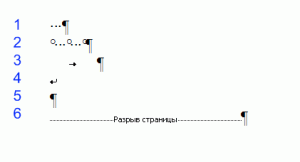 Non-printable characters are:
Non-printable characters are:
- Space
- Non-breaking space
- Tab
- Force line completion
- End a paragraph
- Page break
- Section break
1.Space - everything is clear with this, it is needed to separate words from each other.
2. Non-breaking space... There are times when, when changing the text, the initials from the surname are torn off (appear on different lines). Non-expandable (non-breaking) space (hotkeys - Ctrl+ Shift + Space) does not break words in different lines between which it is inserted (it is convenient to use in cases: 2012; Petrov A.A., 234 rubles) and keeps the value of this space unchanged for any paragraph alignment (it does not stretch, unlike a regular space) ...
3.Tab... This is a large separate topic, so I'll write in detail about tabs here.
4.Force termination strings (Hotkeys - Shift+ Enter) used when you yourself need to complete a line within a paragraph; when you need to skip a line. After pressing the keyboard shortcut Shift+ Enter, no new paragraph starts!
5.Paragraph end key appears after pressing the key Enter... In this case, all the signs of paragraph formatting appear (spacing before, after, line spacing, and so on).
6.Page break... A very handy feature. It is used for large, several chapters, texts. If you want each new chapter to start with new page, you can achieve this in two ways.
1st method - as simple as the world, used by novice users - this is the key Enter. Clicked a certain number of times, reached a new page and you're done. Now imagine that several lines have been added to the first page of your text. What happened to all the new chapters? That's right, they have shifted. Therefore, it is better to use the second method. It consists in the fact that after each chapter a non-printable character is placed Page break using a keyboard shortcut Ctrl +Enter. After this symbol, all information will be located on a new page.
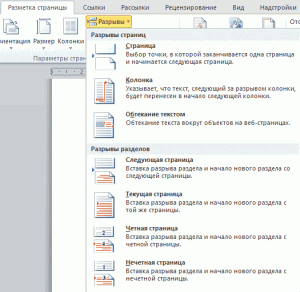 7.Finally, a very useful non-printable character - Section break... When is it needed? Let's say you have a large document that uses different Page settings (let's say two types of orientation - Bookstore and Landscape). If you change the page orientation, then it changes for the entire document. It remains to apply the section break. Tab Page layout, Breaks... (see fig). You can set a column break, section break, indicate where the next section will begin (on this page or not the next). In addition, the concept of a section is also used in setting page parameters, which can be applied to the entire document or only to a specific section.
7.Finally, a very useful non-printable character - Section break... When is it needed? Let's say you have a large document that uses different Page settings (let's say two types of orientation - Bookstore and Landscape). If you change the page orientation, then it changes for the entire document. It remains to apply the section break. Tab Page layout, Breaks... (see fig). You can set a column break, section break, indicate where the next section will begin (on this page or not the next). In addition, the concept of a section is also used in setting page parameters, which can be applied to the entire document or only to a specific section.